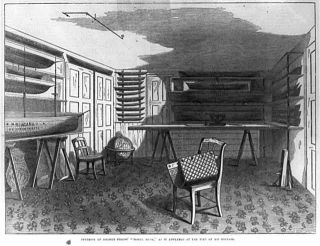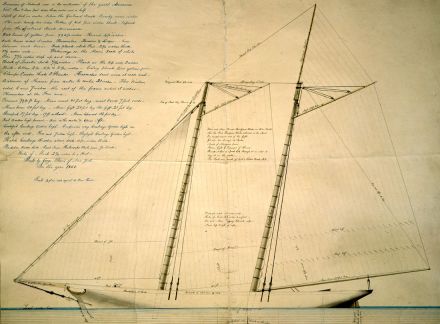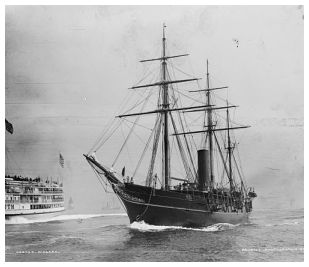Steers, George (1819–1856) USA
Yves GARY Hits: 3355
Category: DESIGNERS
 George Steers (Aug. 15, 1819 – Sept. 25, 1856) one of 13 children, was born in Washington, USA. His father Henry Steers was engaged as Naval Constructor for the U.S. Government. He was a native of Devonshire, England, and learned his trade at the Royal dockyard at Devonport, coming to this country in 1819 and securing employment at the Washington navy yard. In 1827 the older Steers removed with his family to New York, where he built the first government dry-dock.
George Steers (Aug. 15, 1819 – Sept. 25, 1856) one of 13 children, was born in Washington, USA. His father Henry Steers was engaged as Naval Constructor for the U.S. Government. He was a native of Devonshire, England, and learned his trade at the Royal dockyard at Devonport, coming to this country in 1819 and securing employment at the Washington navy yard. In 1827 the older Steers removed with his family to New York, where he built the first government dry-dock.
 He also constructed a semaphore telegraph system between Sandy Hook and New York. George Steers grew up in the atmosphere of a shipyard, and learned his father's trade, as did also three of his brothers, James R., Henry T. and Philip.
He also constructed a semaphore telegraph system between Sandy Hook and New York. George Steers grew up in the atmosphere of a shipyard, and learned his father's trade, as did also three of his brothers, James R., Henry T. and Philip.
At ten years of age, for his own amusement, he built a scow eight feet long, which an older brother broke to pieces lest George should get drowned. When 16 years old, George Steers designed and built his first boat, the Martin Van Buren, 17 feet long and very sharp bow, with which he attracted the attention of New York sportsmen by defeating the champion Gladiator three miles in twenty-four, for a prize offered by John C. Stevens. In 1841 he built a rowboat 30 feet long that weighed but 140 pounds, and with its crew aboard drew but four inches of water. Racing with rowboats was then in favor in New York, and this boat was named for John C. Stevens, who was a leading patron of the sport. Beat the Unexpected, the Sylph, the Brooklyn, J. W. Willis, Johnny on the Green, and many other well-known boats. Upon examination it was shown that she was the lightest, as she was believed to be the fastest boat of the kind in the world.
At nineteen, he built the Manhattan sail boat of twenty-seven tons, forty-four feet in length, fourteen feet eight inches beam, six feet deep. At twenty-one, he built the pilot boat Wm. G. Hagstaff, for the Jersey pilots. Her speed was so great that she passed with ease any of the boats belonging to the New York pilots, creating a deal of animosity among the New Yorkers against its builder. This boat was sold and carried to California, and was finally wrecked at the mouth of the Columbia River, and every remnant left from the storm was burnt up by the Indians. The Syren and Sybil were next built for the New York Yacht Club, very fast and very popular boats.
In 1842 Mr. Steers built the schooner St. Mary the First, of two hundred and fifty tons burthen, which could beat any schooner that ever went outside of Sandy Hook. This vessel was finally sold to the government in the Mexican war to carry two great guns to Vera Cruz, to be used in the bombardment of that city. She after was running regularly between Baltimore and Rio Janeiro.
 In 1845 George Steers entered into business with a partner, under the firm name of Hathorne & Steers, their yard being in Williamsburg. Here he designed and built the pilot-boat Mary Taylor at the beginning of his business career, the principle of her design being that which he afterward employed in every craft he laid down— "that for a vessel to sail easily, steadily and rapidly, the displacement of water must be nearly uniform along her lines."
In 1845 George Steers entered into business with a partner, under the firm name of Hathorne & Steers, their yard being in Williamsburg. Here he designed and built the pilot-boat Mary Taylor at the beginning of his business career, the principle of her design being that which he afterward employed in every craft he laid down— "that for a vessel to sail easily, steadily and rapidly, the displacement of water must be nearly uniform along her lines."
The Mary Taylor was followed by several other fast crafts. The firm of Hathorne & Steers was dissolved in 1849, and it was while waiting a proper opportunity to engage again in business for himself that George Steers designed and built the America at the at the yard of William H. Brown in New York.
Shortly after the building of the America George Steers formed a partnership with his brother James, under the firm name of J. R. & G. Steers. They revived building at the Williamsburg yard, and turned out several famous vessels, including Julia, the Pride of the Seas which they say has sailed faster than any other vessel ever built; the Sunny South, a flying clipper, and a whole fleet of lovely yachts.
The last ships were the U. S. frigate Niagara a steam fregate and the Collins’ steamer Adriatic.  This beautiful vessel, the greatest triumph of American art which was launched from the ship-yard of James and George Steers, at the foot of Seventh street, at 11 o'clock, on Monday, the 7th of April, 1856. The crowd in attendance was larger than was ever before known in this city on any similar occasion— having been computed at 100,000 people.
This beautiful vessel, the greatest triumph of American art which was launched from the ship-yard of James and George Steers, at the foot of Seventh street, at 11 o'clock, on Monday, the 7th of April, 1856. The crowd in attendance was larger than was ever before known in this city on any similar occasion— having been computed at 100,000 people.
George Steers was cut off at the height of his career, dying on September 25, 1856, at the age of 36 years, from injuries received by being thrown from a carriage while driving. He had just negotiated for $1,000,000 worth of boats for the Czar of Russia. He left a son behind him. A procession of 800 citizens was followed by lodges of the Masonic Order, including the Mariner's Lodge (400 men), and 70 carriages of friends and relatives. Steers is interred at Green-Wood Cemetery in Brooklyn, New York.

USEFUL LINKS
George Steers - Wikipedia, the free encyclopedia
- George Steers the ship-builder - The book of one thousand tales and amusing adventures: a work for youth - Google Livres
- GEORGE STEERS - The Sailor's Magazine - Google Livres
- Olin J. Stephens II Collection (Coll. 266) - Mystic Seaport
- George Steers, 1998 Inductee - Herreshoff Marine Museum & America's Cup Hall of Fame
- George Steers papers 1851-1856 - William M. Clements Library
